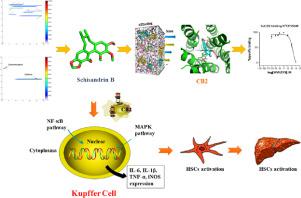Phytomedicine ( IF 6.7 ) Pub Date : 2022-01-29 , DOI: 10.1016/j.phymed.2022.153960 Hai-Qiao Wang 1 , Zhong Wan 2 , Qiqiang Zhang 3 , Tong Su 4 , Dan Yu 4 , Fei Wang 4 , Chao Zhang 4 , Wei Li 4 , Dongliang Xu 2 , Hai Zhang 3

|
Background
Lignans, the major bioactive components of Schisandra chinensis, displays an anti-liver fibrosis effect. However, which one is the most effective lignan and what is its molecular mechanisms are still unclear.
Purpose
This research aimed to screen the most effective components of lignans, identify and verify its pharmacological target, and investigate its molecular mechanism against liver fibrosis.
Methods
First, the most effective lignans were screened by a comprehensive RAW264.7/CMC system and LPS-induced RAW264.7. Second, the potential targets were predicted by a liver fibrosis domain-specific chemo-genomics knowledgebase and further verified by competition binding assay. Third, the effect of anti-liver fibrosis was evaluated by employing RAW264.7, co-cultured hepatic stellate cells (HSC) and CCl4-induced liver fibrosis CB2−/− mice. The qPCR, ELISAs, western blot analyses, and immunofluorescence were used to evaluate the expression of main inflammatory factors and key proteins in NF-κB and p38 MAPK pathway.
Results
Schisandrin B was identified as the most effective component for attenuating liver fibrosis, and CB2 was proven to be a potential target for anti-liver fibrosis. The in vitro and in vivo assays indicated that schisandrin B ameliorated CCl4-induced liver fibrosis through suppressing NF-κB and p38 MAPK pathway in Kupffer cells by targeting CB2 receptor
Conclusion
Schisandrin B targets CB2 receptor to inhibit Kupffer cell polarization by downregulating the NF-κB and p38 MAPK signaling pathways for ameliorating liver fibrosis.
中文翻译:

五味子 B 靶向 Kupffer 细胞中的大麻素 2 受体,通过抑制 NF-κB 和 p38 MAPK 通路改善 CCl4 诱导的肝纤维化
背景
木脂素是五味子的主要生物活性成分,具有抗肝纤维化作用。然而,哪一种是最有效的木脂素及其分子机制仍不清楚。
目的
本研究旨在筛选木脂素最有效的成分,鉴定并验证其药理靶点,并探讨其抗肝纤维化的分子机制。
方法
首先,通过综合RAW264.7/CMC系统和LPS诱导的RAW264.7筛选最有效的木脂素。其次,通过肝纤维化域特异性化学基因组学知识库预测潜在靶点,并通过竞争结合测定进一步验证。第三,使用RAW264.7、共培养的肝星状细胞(HSC)和CCl 4诱导的肝纤维化CB2 -/-小鼠评价抗肝纤维化的效果。采用qPCR、ELISA、蛋白质印迹分析和免疫荧光来评估主要炎症因子和NF-κB和p38 MAPK通路中关键蛋白的表达。
结果
五味子乙素被认为是减轻肝纤维化最有效的成分,而CB2被证明是抗肝纤维化的潜在靶点。体外和体内实验表明,五味子乙素通过靶向CB2受体,抑制Kupffer细胞中的NF-κB和p38 MAPK通路,从而改善CCl 4 诱导的肝纤维化
结论
五味子 B 靶向 CB2 受体,通过下调 NF-κB 和 p38 MAPK 信号通路抑制库普弗细胞极化,从而改善肝纤维化。






























 京公网安备 11010802027423号
京公网安备 11010802027423号